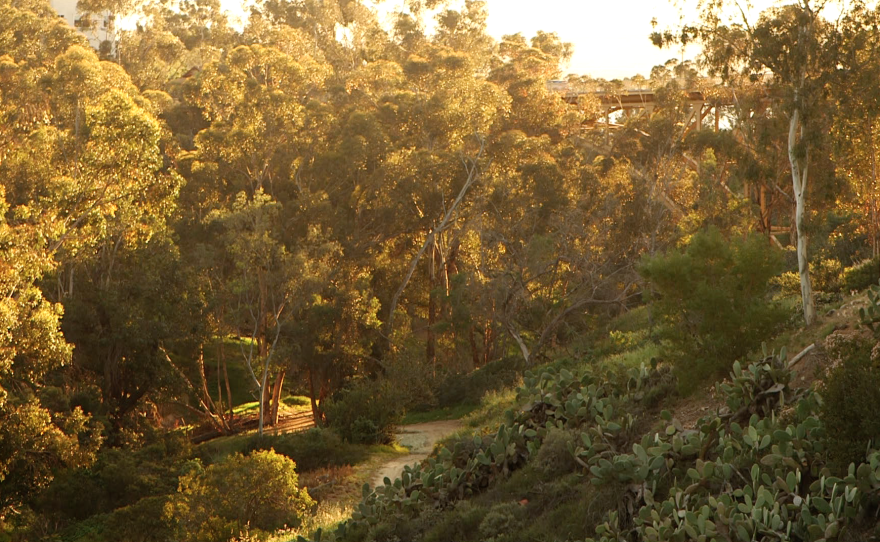Stepping into the Truax House is like a step back in time. The vacant three-story house in the Bankers Hill neighborhood is impressive, not just for its stunning craftsman-style design but also for the crucial role it played as San Diego's first AIDS hospice.
Faced with the high cost of restoration and a perpetually constrained budget, the city of San Diego is considering selling the Truax House, along with an adjacent house occupied by renters. The sale was approved by the Smart Growth and Land Use Committee and awaits review by the full City Council.
The Truax House is caught in the middle of a number of sometimes competing interests, including the city's Real Estate Assets Department, historical preservationists, advocates for the nearby Maple Canyon hiking trail and those raising money for a San Diego AIDS memorial.
What no one disputes is that the house has immense historic value, and that the city would be losing a part of its history should it one day be razed by a developer.
A symbol of unity
The Truax House was built in 1912 and purchased by the city of San Diego in the 1960s as part of plans to build a road through Maple Canyon. It was named in September 1988 after Dr. Brad Truax, a local gay physician and early AIDS activist. He died of complications from AIDS months after the house's naming.
Terry Cunningham, a retired San Diego County public health director, helped raise the money to get the Truax House up and running. As he recently walked through the house, he recalled the darkest days of the AIDS epidemic, when fear and stigma were rampant. Some families of deceased AIDS patients refused to claim their relatives' bodies at the San Diego County Medical Examiner's Office.
"There were people that were literally dropped off at this doorstep," Cunningham said. "Because people just had no place to go. ... They would have an apartment, and a partner or a family, and next minute they didn't — because they had disclosed that they had AIDS."
He said everything in the house, from the furniture to the outdoor wheelchair ramp, was obtained through donations.
"The house is a symbol of that unity of the gay community to address the needs of people with AIDS," Cunningham said.
Cost of restoration
Three assessments have been done on the cost of restoring the house, each coming to substantially different conclusions. The first, completed in 2012 by Father Joe's Village, which was the last operator of the house, put the cost around $270,000.

The most recent and most thorough assessment, completed on Feb. 26, estimated that bringing the house to "like new" condition would cost $1.8 million. A city spokesman said that figure assumed the house's plumbing, heating, ventilation and air conditioning systems would be fully replaced, not repaired.
Todd Gloria, who represents Bankers Hill on the City Council, said at the Feb. 10 committee meeting on the property's sale that "the status quo is not working."
"As the chair of the budget committee, I'm also mindful of the fact that — I think it's unlikely the city would ever prioritize this for the kind of rehabilitation that would be necessary," he said.
Some have called for the Truax House to be sold and for the proceeds to go toward building a San Diego AIDS memorial. But because the house was purchased with money from the city's gas tax fund, money from the sale must be returned to that fund. Donating money to the AIDS memorial would require a crafty shifting of resources in the city budget.
Maple Canyon trail extension
Gloria proposed selling the Truax House on the condition that the city perform a review of the site's historical significance. But that solution has not impressed everyone.
"Historic designations do not prevent things from getting torn down," said Roy McMakin, president of Friends of Maple Canyon. "They're a speed bump from developers, but I think that it is possible that someone would buy (the Truax House) with a historic designation and be able to prove a financial hardship to restore it."

McMakin said the property on West Laurel Street near Union Street offers the perfect site for an extension of the Maple Canyon trail — one that would offer a spectacular view of San Diego Bay. The city's Park and Recreation Department passed on converting the property into park space because of topographical challenges, and because a trail extension would require easements through private property.
While city staffers may have decided among themselves that there was no feasible public use of the house or the land it sits on, McMakin said they neglected to consult the Bankers Hill community. He said he thought the sale of the property would be "shortsighted."
"The Truax House has so many possibilities for public benefit and public use," McMakin said. "I'm really at a loss as to why the city is just so anxious to sell it so quickly. It's really just bewildering to me."
There may be a solution that would satisfy everyone: A developer has expressed interest in buying the property, restoring the Truax House, keeping it as a public meeting space and working to extend the Maple Canyon trail. The developer didn’t want to be named because the property is not yet officially on the market.
The plans have been welcomed by several people involved with trying to preserve the Truax House, and city staffers are researching whether conditions can be placed on the property's sale to ensure public benefit. They're still preparing an item to present to the City Council for a vote.






